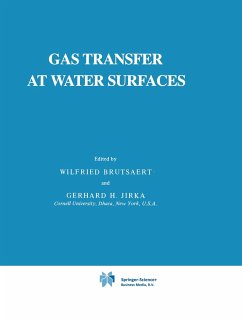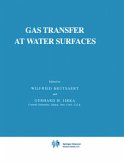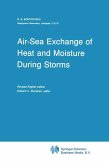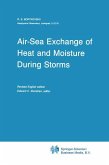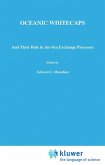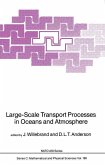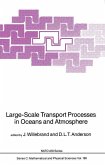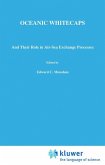Gas Transfer at Water Surfaces
Herausgegeben von Brutsaert, W.; Jirka, G.H.
Gas Transfer at Water Surfaces
Herausgegeben von Brutsaert, W.; Jirka, G.H.
- Broschiertes Buch
- Merkliste
- Auf die Merkliste
- Bewerten Bewerten
- Teilen
- Produkt teilen
- Produkterinnerung
- Produkterinnerung
The transfer across the surface of environmental waters is of interest as an important phase in the geophysical and natural biochemical cycles of numer ous substances; indeed it governs the transition, one way or the other, be tween the dissolved state in the water and the gaseous state in the atmo sphere. Especially with increasing population and industrialization, gas transfer at water surfaces has become a critical factor in the understanding of the various pathways of wastes in the environment and of their engineering management. This interfacial mass transfer is, by its very nature,…mehr
Andere Kunden interessierten sich auch für
![Gas Transfer at Water Surfaces Gas Transfer at Water Surfaces]() W. Brutsaert / G.H. Jirka (Hgg.)Gas Transfer at Water Surfaces163,99 €
W. Brutsaert / G.H. Jirka (Hgg.)Gas Transfer at Water Surfaces163,99 €![Air-Sea Exchange of Heat and Moisture During Storms Air-Sea Exchange of Heat and Moisture During Storms]() R. S. BortkovskiiAir-Sea Exchange of Heat and Moisture During Storms121,99 €
R. S. BortkovskiiAir-Sea Exchange of Heat and Moisture During Storms121,99 €![Air-Sea Exchange of Heat and Moisture During Storms Air-Sea Exchange of Heat and Moisture During Storms]() R. S. BortkovskiiAir-Sea Exchange of Heat and Moisture During Storms121,99 €
R. S. BortkovskiiAir-Sea Exchange of Heat and Moisture During Storms121,99 €![Oceanic Whitecaps Oceanic Whitecaps]() E.C. Monahan / Gear¢id Mac Niocaill (Hgg.)Oceanic Whitecaps121,99 €
E.C. Monahan / Gear¢id Mac Niocaill (Hgg.)Oceanic Whitecaps121,99 €![Large-Scale Transport Processes in Oceans and Atmosphere Large-Scale Transport Processes in Oceans and Atmosphere]() Large-Scale Transport Processes in Oceans and Atmosphere121,99 €
Large-Scale Transport Processes in Oceans and Atmosphere121,99 €![Large-Scale Transport Processes in Oceans and Atmosphere Large-Scale Transport Processes in Oceans and Atmosphere]() J. Willebrand / D.L.T. Anderson (Hgg.)Large-Scale Transport Processes in Oceans and Atmosphere121,99 €
J. Willebrand / D.L.T. Anderson (Hgg.)Large-Scale Transport Processes in Oceans and Atmosphere121,99 €![Oceanic Whitecaps Oceanic Whitecaps]() Oceanic Whitecaps121,99 €
Oceanic Whitecaps121,99 €-
-
-
The transfer across the surface of environmental waters is of interest as an important phase in the geophysical and natural biochemical cycles of numer ous substances; indeed it governs the transition, one way or the other, be tween the dissolved state in the water and the gaseous state in the atmo sphere. Especially with increasing population and industrialization, gas transfer at water surfaces has become a critical factor in the understanding of the various pathways of wastes in the environment and of their engineering management. This interfacial mass transfer is, by its very nature, highly complex. The air and the water are usually in turbulent motion, and the interface be tween them is irregular, and disturbed by waves, sometimes accompanied by breaking, spray and bubble formation. Thus the transfer involves a wide variety of physical phenomena occurring over a wide range of scales. As a consequence, scientists and engineers from diverse disciplines and problem areas, have approached the problem, often with greatly differing analytical and experimental techniques and methodologies.
Hinweis: Dieser Artikel kann nur an eine deutsche Lieferadresse ausgeliefert werden.
Hinweis: Dieser Artikel kann nur an eine deutsche Lieferadresse ausgeliefert werden.
Produktdetails
- Produktdetails
- Water Science and Technology Library Vol.2
- Verlag: Springer / Springer Netherlands
- Artikelnr. des Verlages: 978-90-481-8393-7
- Softcover reprint of the original 1st ed. 1984
- Seitenzahl: 656
- Erscheinungstermin: 28. Oktober 2010
- Englisch
- Abmessung: 279mm x 210mm x 36mm
- Gewicht: 1572g
- ISBN-13: 9789048183937
- ISBN-10: 9048183936
- Artikelnr.: 32094819
- Herstellerkennzeichnung Die Herstellerinformationen sind derzeit nicht verfügbar.
- Water Science and Technology Library Vol.2
- Verlag: Springer / Springer Netherlands
- Artikelnr. des Verlages: 978-90-481-8393-7
- Softcover reprint of the original 1st ed. 1984
- Seitenzahl: 656
- Erscheinungstermin: 28. Oktober 2010
- Englisch
- Abmessung: 279mm x 210mm x 36mm
- Gewicht: 1572g
- ISBN-13: 9789048183937
- ISBN-10: 9048183936
- Artikelnr.: 32094819
- Herstellerkennzeichnung Die Herstellerinformationen sind derzeit nicht verfügbar.
1. Physico-Chemical Fundamentals.- Physical-chemical phenomena and molecular properties.- The determination of Henry's Constant for volatile organics by equilibrium partitioning in closed systems.- Volatilization of chlorinated hydrocarbons from water.- The ratio of gas-phase to liquid-phase mass transfer coefficients in gas-liquid contacting processes.- Absorption of gases at condensing and evaporating water surfaces.- The effects of evaporation and condensation on an absorption process.- 2. Turbulence near Gas-Liquid Interfaces.- Turbulence structure and turbulent diffusion near gas-liquid interfaces.- Turbulence measurements near the free surface in stirred grid experiments.- A laboratory technique for investigating the relationship between gas transfer and fluid turbulence.- Carbon dioxide transfer at the gas/water interface as a function of system turbulence.- Turbulence structure of wavy stratified air-water flow.- Current fluctuations in the surface waters of small lakes.- Moisture and heat transport in a stably stratified boundary layer over a water surface.- 3. Interfacial Motions and Instabilities.- Wind-wave effects on gas transfer.- Interfacial motion observed during experiments on air-water gas transfer.- A laboratory study of the velocity field below surface gravity waves.- The roles of Langmuir circulations in gas transfer across natural water surfaces.- Measurements of the fluctuating pressure in the turbulent boundary layer over progressive, mechanically generated water waves.- Experimental studies of surface wave breaking and air entrainment.- Bubbles produced by breaking wind waves.- The role of bubbles for gas transfer from water to air at higher windspeeds. Experiments in the wind-wave facility in Hamburg.- A new optical bubble measuring device; Asimple model for bubble contribution to gas exchange.- Contribution of bubbles to gas transfer across an air-water interface.- Entrapment and transport of bubbles by plunging water.- 4. Conceptual Models and Parameterizations of Gas Transfer.- Conceptual models of gas exchange.- A comparison of turbulent mass transfer at gas-liquid and solid-liquid interfaces.- The variation of the gas transfer coefficient with molecular diffusity.- Wind/wave-tunnel experiment on the Schmidt number - and wave field dependence of air/water exchange.- A model of interfacial gas transfer for a well-roughened sea.- Turbulent transfer across smooth and rough surfaces.- Reaeration of open channel flow.- Dependence of oxygen transfer rate on energy dissipation during surface aeration and in stream flow.- Wind effects on air-water oxygen transfer in a lake.- Reaeration and wind induced turbulence shear in a contained water body.- 5. Field and Laboratory Experimental Techniques.- Field techniques for reaeration measurements in rivers.- Gas transfer rate coefficient measurement of wastewater aeration equipment by a stable isotope krypton/lithium technique.- Reaeration studies on some New Zealand rivers using methyl chloride as a gas tracer.- Dichlorodifluoromethane (Freon-12) as a tracer for nitrous oxide release from a nitrogen-enriched river.- An assessment of the radiotracer technique for measuring reaeration rates in large river systems.- Measurements of wind effects on water-side controlled gas exchange in riverine systems.- Optimum application of the radon deficit method to obtain air-sea gas exchange rates.- Parametrization of air/lake gas exchange.- Simultaneous in situ determination of dissolved gases by gas chromatography.- 6. Climate and Oceanographic Applications.- Gas exchangemeasurements in natural systems.- The role of oceanic whitecaps in air-sea gas exchange.- On the exchange of oxygen and carbon dioxide between ocean and atmosphere in an eastern boundary current.- Invasion of fossil fuel CO2 into the ocean.- In situ pH measurements as an indicator of CO2 gas transfer in glacial meltwaters.- The transfer of mercury at the air/water interface.- Exchange rates of dimethyl sulfide between ocean and atmosphere.- Laboratory observations on transfer of atmospheric oxygen into stratified seawater.- 7. Water Quality and Engineering Applications.- The significance of gas exchange in water quality assessment and planning.- The sensitivity of the dissolved oxygen balance to predictive reaeration equations.- Estimation of volatilization of toxics for multimedia modeling.- Reaeration measurement in swamp streams: Radiotracer case studies.- Prediction of dissolved gas transfer in spillway and outlet works stilling basin flows.- Carbon dioxide desorption from the activated sludge at the waste water treatment plants.- Volatilization of fission products in nuclear reactor buildings.- Self-propelled weir aerators.
1. Physico-Chemical Fundamentals.- Physical-chemical phenomena and molecular properties.- The determination of Henry's Constant for volatile organics by equilibrium partitioning in closed systems.- Volatilization of chlorinated hydrocarbons from water.- The ratio of gas-phase to liquid-phase mass transfer coefficients in gas-liquid contacting processes.- Absorption of gases at condensing and evaporating water surfaces.- The effects of evaporation and condensation on an absorption process.- 2. Turbulence near Gas-Liquid Interfaces.- Turbulence structure and turbulent diffusion near gas-liquid interfaces.- Turbulence measurements near the free surface in stirred grid experiments.- A laboratory technique for investigating the relationship between gas transfer and fluid turbulence.- Carbon dioxide transfer at the gas/water interface as a function of system turbulence.- Turbulence structure of wavy stratified air-water flow.- Current fluctuations in the surface waters of small lakes.- Moisture and heat transport in a stably stratified boundary layer over a water surface.- 3. Interfacial Motions and Instabilities.- Wind-wave effects on gas transfer.- Interfacial motion observed during experiments on air-water gas transfer.- A laboratory study of the velocity field below surface gravity waves.- The roles of Langmuir circulations in gas transfer across natural water surfaces.- Measurements of the fluctuating pressure in the turbulent boundary layer over progressive, mechanically generated water waves.- Experimental studies of surface wave breaking and air entrainment.- Bubbles produced by breaking wind waves.- The role of bubbles for gas transfer from water to air at higher windspeeds. Experiments in the wind-wave facility in Hamburg.- A new optical bubble measuring device; Asimple model for bubble contribution to gas exchange.- Contribution of bubbles to gas transfer across an air-water interface.- Entrapment and transport of bubbles by plunging water.- 4. Conceptual Models and Parameterizations of Gas Transfer.- Conceptual models of gas exchange.- A comparison of turbulent mass transfer at gas-liquid and solid-liquid interfaces.- The variation of the gas transfer coefficient with molecular diffusity.- Wind/wave-tunnel experiment on the Schmidt number - and wave field dependence of air/water exchange.- A model of interfacial gas transfer for a well-roughened sea.- Turbulent transfer across smooth and rough surfaces.- Reaeration of open channel flow.- Dependence of oxygen transfer rate on energy dissipation during surface aeration and in stream flow.- Wind effects on air-water oxygen transfer in a lake.- Reaeration and wind induced turbulence shear in a contained water body.- 5. Field and Laboratory Experimental Techniques.- Field techniques for reaeration measurements in rivers.- Gas transfer rate coefficient measurement of wastewater aeration equipment by a stable isotope krypton/lithium technique.- Reaeration studies on some New Zealand rivers using methyl chloride as a gas tracer.- Dichlorodifluoromethane (Freon-12) as a tracer for nitrous oxide release from a nitrogen-enriched river.- An assessment of the radiotracer technique for measuring reaeration rates in large river systems.- Measurements of wind effects on water-side controlled gas exchange in riverine systems.- Optimum application of the radon deficit method to obtain air-sea gas exchange rates.- Parametrization of air/lake gas exchange.- Simultaneous in situ determination of dissolved gases by gas chromatography.- 6. Climate and Oceanographic Applications.- Gas exchangemeasurements in natural systems.- The role of oceanic whitecaps in air-sea gas exchange.- On the exchange of oxygen and carbon dioxide between ocean and atmosphere in an eastern boundary current.- Invasion of fossil fuel CO2 into the ocean.- In situ pH measurements as an indicator of CO2 gas transfer in glacial meltwaters.- The transfer of mercury at the air/water interface.- Exchange rates of dimethyl sulfide between ocean and atmosphere.- Laboratory observations on transfer of atmospheric oxygen into stratified seawater.- 7. Water Quality and Engineering Applications.- The significance of gas exchange in water quality assessment and planning.- The sensitivity of the dissolved oxygen balance to predictive reaeration equations.- Estimation of volatilization of toxics for multimedia modeling.- Reaeration measurement in swamp streams: Radiotracer case studies.- Prediction of dissolved gas transfer in spillway and outlet works stilling basin flows.- Carbon dioxide desorption from the activated sludge at the waste water treatment plants.- Volatilization of fission products in nuclear reactor buildings.- Self-propelled weir aerators.

